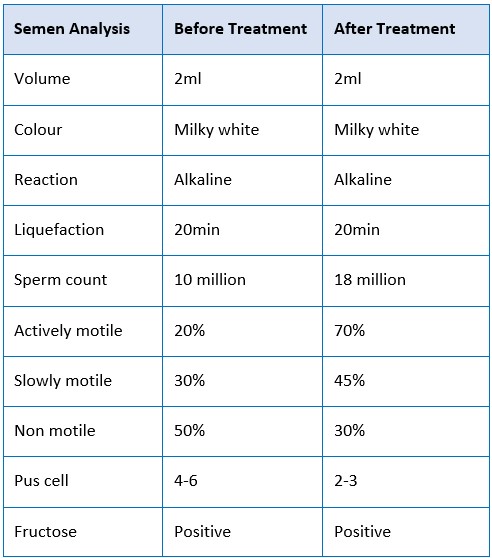Ayurvedic management in Male Infertility w.s.r. to Oligoasthenospermia : A Retrospective Case Series
DOI:
https://doi.org/10.21760/jaims.8.9.33Keywords:
Oligoasthenospermia, Ashwagandha Churna, Male infertility, Uttarbasti, Shukrajananavati, Gokshura ChurnaAbstract
Male infertility refers to a male's inability to result pregnancy in a fertile female and it has a strong impact on psychology of couple. Almost 30-40% of Infertility cases found to be of due to male factor. Oligoasthenospermia (low sperm count and low sperm motility) is one of the main noted causes of male infertility. Author present a case series of three male patients visited the Outpatient department of Prasutitantra evam Streeroga, P D Patel Ayurvedic Hospital, Nadiad, Gujarat with complains of unable to conceive her partner even after having regular unprotected coitus more than one year of married life. Semen analysis of these patients revealed low sperm count (<15 million/ml) and low sperm motility (<40%). Patients were treated with oral medicaments of Shukrajananavati, a combination of Ashwagandha Churna 2g and Gokshura Churna 1g for 3 months. Along with oral medicaments one sitting of 6 days intra urethral Uttarbasti of Narayana Taila was given to all the patients. The effect of therapy was assessed on the bases of improvement in sperm motility and count. After 3 months, semen analysis report of all three patients showed an increase sperm count and marked improvement in sperm motility. The present findings and the effective management of Oligoasthenospermia with Ayurveda formulations highlight the promising scope of traditional medicine in male infertility.
Downloads
References
D.C. Dutta's Textbook of Gynaecology, D.C. Dutta: 6th Edition, Chapter 16, Page 227
WHO Criteria for normal semen gram 2010.Impact of the new WHO Guidelines on diagnosis and practice on male infertility, the open reproductive science journal, Vol-3, 2010 page 7-15
Practice Committee of the American Society for Reproductive Medicine. Definitions of infertility and recurrent pregnancy loss. Fertil Steril. 2008;90 (5 Suppl):S60
Sadock BJ, Sadock VA. 9th ed. Philadelphia: Lippincott Williams and Wilkins; 2003. Kaplans and Sadocks Symptoms of Psychiatry Behavioral Sciences Clinical Psychiatry; pp. 872–4.
4th ed. Cambridge: Cambridge University Press; 1999. World Health Organization. WHO Laboratory Manual for the Examination of Human Semen and Semen-Cervical Mucus Interaction; pp. 1–86.
Butt F, Akram N. Semen analysis parameters: Experiences and insight into male infertility at a tertiary care hospital in Punjab. J Pak Med Assoc. 2013;63:558–62.
Carlsen E, Giwercman A, Keiding N, Skakkebaek NE. Evidence for decreasing quality of semen during past 50 years. BMJ. 1992;305:609–13.
Charak Samhita, Dr shashirekha H. K. Dr bargale Sushant sukumar vol. 5th sidhhi sthan chapter 9 page 275
Ambiye VR, Langade D, Dongre S, Aptikar P, Kulkarni M, Dongre A, Clinical Evaluation of the Spermatogenic Activity of the Root Extract of Ashwagandha (Withaniasomnifera) in Oligospermic Males: A Pilot Study, Evid Based Complement Alternat Med. 2013; 2013: 571420. doi: 10.1155/2013/571420. Epub, Nov 2013; 28.
Thirunavukkarasu M. Sellandi, Anup B. Thakar, Madhav Singh Baghel, Clinical study of Tribulusterrestris Linn. In Oligozoospermia: A double blind study.















